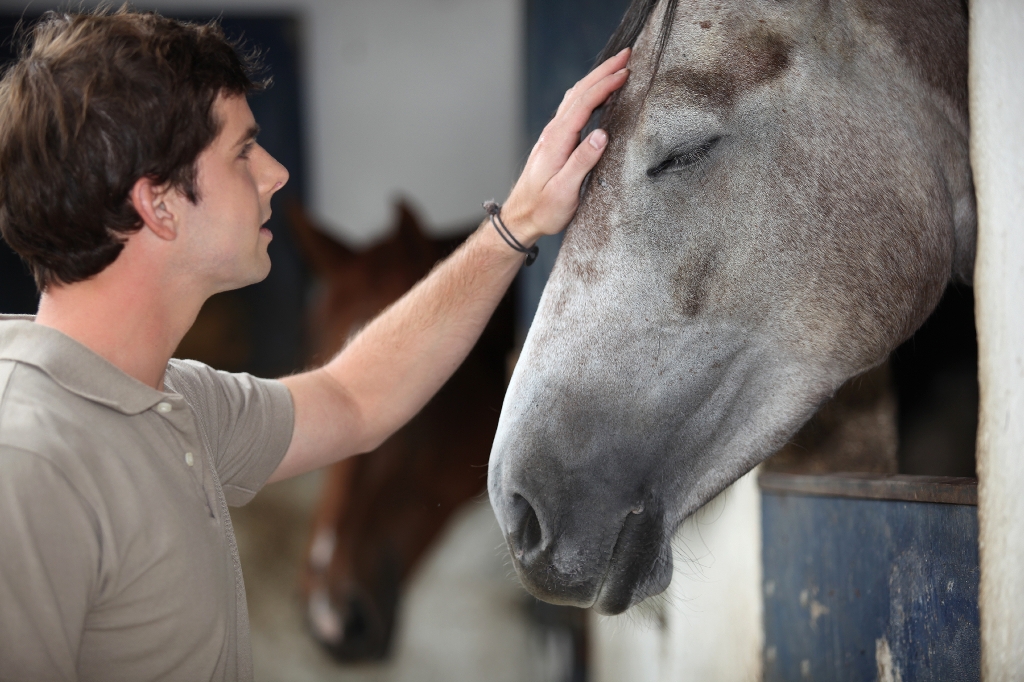As the Leo Bustad Companion Animal Veterinarian of the Year 2012, I now find I am often asked, “How does one believe in the Human-Animal Bond being practice critical?” The truth is that most professionals think that when they believe/know, then they can act. While that works some of the time, if you choose to act first, and KNOW that will create your belief . . . well, that works also. For me, I have always believed, ever since I learned to read the body language of the horses I was training in Montana about 45 years ago. Leo Bustad provided me the term ‘Human-Animal Bond’ over 30 years ago as he was organizing and promoting the Delta Society, and that phrase has been my defining value ever since. My favorite text, Promoting the HAB in Veterinary Practice, circa 2009, VIN Press, is now in second edition (over 250 pages, with 26 ‘staff friendly’ client-bonding appendices) and available for FREE DOWNLOAD from the VIN Library (www.vin.com).
It is all about LEADERSHIP, not management, and you cannot be oblivious to what people think about you. Leo’s leadership was subtle – no self-promoting, just the HAB promotion. Effective leaders have effective followers, and Leo had just that, and the Delta Society became an international force in the HAB awareness. Most staff assume the practice owner knows what they are doing, so suggestions, comments, and even inquiries are usually rare events. The most dangerous practice that I consult with is one where the owner assumes he/she knows what the clients are thinking, and secondarily, what the staff is thinking. Survey after survey shows neither group is effectively understood by the practice owner(s), and the depth of the human-animal bond (HAB) is much deeper in client families than most veterinary practice teams care to admit. Another dangerous time is when the staff member is trying to provide feedback about a HAB aspect of client-patient encounter and the boss disagrees, interrupts, or tries to pinpoint the event so they can defend themselves. The servant leader sits back and listens, and hopefully, takes notes. This savvy leader lets the comments sink into their thought pattern, then asks themselves what one thing they can do differently to show they were listening, showing they have learned from the feedback session.
It is NOT about “turf protection”, it is about client-centered patient advocacy. Sure, most any practice owner has climbed the ladder of success, crossed the swamp of the unknown, and been to the school of hard knocks; a few are taken aback when someone challenges that depth of experience. Most experienced veterinarians have developed a sensitivity to the HAB of clients, but our academic training drained the feelings from our soul and replaced it with a logical medical/surgical approach to patient care. Instead of searching only for what is best for you and the practice, hold the primary mission in mind and look at the client-centered patient advocacy needed to build a practice in today’s saturated veterinary market; look for the win-win from the perspective of the client, patient, and practice staff. Effective leaders rely upon building and maintaining relationships to get things done. Strengthening trust will increase your level of influence and positional power.
The fact is that management cannot learn by experience alone what they must do to improve quality, productivity, and their competitive position in the community. Everyone doing their best is not the answer. W. Edwards Deming
If you are having a problem seeing the big picture, understand that your training has been a series of academic knot holes, looking at pathology and diseases, as well as injury and other atypical health situations, and understand that current surveys show that veterinary students are graduating with 25% more fear than when they entered the curriculum. Veterinary education has traditionally been by intimidation, repetition and rote, with grading on a bell curve so instructors can blame the student for not learning. How often do you use these questions:
- What happened this past week that we can celebrate or learn from?
- What is coming this week that we can help each other with?
- What is coming down the road that we need to prepare for?
Some readers are now questioning why each question ended in a prepositional phrase, rather than answering the introductory question, “How often do you use these questions?” This is the nature of academia and our educational process. Quality Assurance (QA) and Quality Control (QC) has been beaten into us for years – spot check the process to ensure sameness, and spot check the output to ensure sameness. If these are your two management tools, you are NOT allowing change, and in fact, it makes staff members come to you with minor questions. Continuous Quality Improvement (CQI) is a philosophy that each person is accountable for unilaterally improving things within their sphere of influence, and keeping others informed of the upgraded techniques or new procedures that benefit the patient, client, and/or practice.
LEADER OR MANAGER
STICK TO YOUR MISSION – the problem here is our training has been in surgery and medicine, to fix broken critters, yet 70% of our front door swing are pet stewards who want to keep their pet healthy. The Bayer Study Group decided you needed to sell more “stuff”, yet Peter Drucker said in Post Capitalistic Society that anyone can undersell us, and all we have to sell in the new millennium is knowledge. I wrote the text over 10 years ago, Promoting the Human Animal Bond in Veterinary Practice, with 26 plug-and-play appendices, and two years ago, updated it into the second edition with the VIN PRESS people – it is in the VIN Library for FREE DOWNLOAD. Even you can afford that.
LOOK AT YOUR CAPACITY – Go count the empty cages in your practice – now sit back and review the data (and your program commitment) – 85% of the adult animals have a dental need according to our experts – over 50% of our patients are overweight – how many cages are supposed to be dental day care – how many cages are FAT FARM patients (week-or longer weight reduction and refeeding program, with sequential lab work)? What are you doing to track and meet your cage fill requirements?
Standards of Care (SOC) needs to be a written document addressing the wellcare expectations for critters entering your facility. Do not expand it to treatment modalities for common problems until the wellcare system is entrenched and the SOC has become an actual reality in everyone’s daily habits. Every day of CE attendance task the individual to bring back one improvement to the SOC document, for all staff as well as yourself. Those improvements are implemented and kept alive by the CE attendee for 90 days BEFORE team review (e.g., benefit to patient, client, staff, and/or practice).
ACCOUNTABILITY – who maintains the Fat Burner Chart by the food display in the reception area? Every OPN must be ready to add or subtract from the running monthly total as they do a weigh-in of nutrition patients . . . when clients see their pet effect the larger number, they know they are not alone, and feel better about the return visits with the nutritional advisor.
Who augments the OA medical treatments that have stalled? The Photonic Pen works (see www.photonictherapy.com.au for Scientific papers) . . . three weeks, M-W-F, and then when ever limping starts to return, all done by the OA counselors (OPNs).
Who does the dental diet/hygiene visit 7-10 days post prophy, and who does the 4-6 month courtesy dental recheck? It should be the discharge nurse of the dental prophy.
Who is accountable for reviewing the OTHER PETS in the household at each visit? If Client Relations are doing their screening job, there should be notes on every record about other pets past due for healthcare screening or wellcare treatment, which the OPN notes, and tells the client, “I have made a note for the doctor to talk to you about this”.
When a doctor tells a client something is NEEDED (kill the word recommend from your vocabulary), who is accountable for the W-D-A-X notation reflecting the client’s response?
Most of you know my mantra about The Practice Success Prescription: Team-based Veterinary Healthcare Delivery (the other book I have in the VIN Library, available as a FREE download). We are missing out as a profession as we play games with protectionism of the doctor, rather than advocacy of the companion animal. But what do I know for sure? Most veterinary practices are led by control-freak doctors – it is how we were taught – the vet is 100% accountable for everything . . . we have an academic heritage that limits our understanding of how to do more with less (e.g., a proactive delegation of outcome accountability to staff members).
This is NOT “back to basics”, it is “forward with fundamentals” . . . try that for a mind set! One step closer is the ‘pet-centered practice’ creating a FEAR FREE philosophy within the practice walls; your patients deserve that! Life moves ii mysterious ways my friends. We now have Feliway pheromones, Thundershirts, Gentle Leader head collars, Clipnosis, and a host of other “tools” that facilitate a FEAR FREE practice environment. We entered this profession because we wanted to tend to the critters, and then the veterinary school culture tried to drive out that feeling and replace it with facts and data points about medicine and surgery. The academic goal was to take those FEELERS that entered the hallowed halls of academia and graduate them as THINKERS. My goal is to reintroduce the HAB at every level of the practice setting, develop client-centered patient advocacy at every level of the practice team, and celebrate the Human-Animal Bond in everything we do for our clients and community. I am not done yet with promotion of the HAB and FEAR FREE philosophy of practice, and it is my hope you will say the same thing tomorrow!






